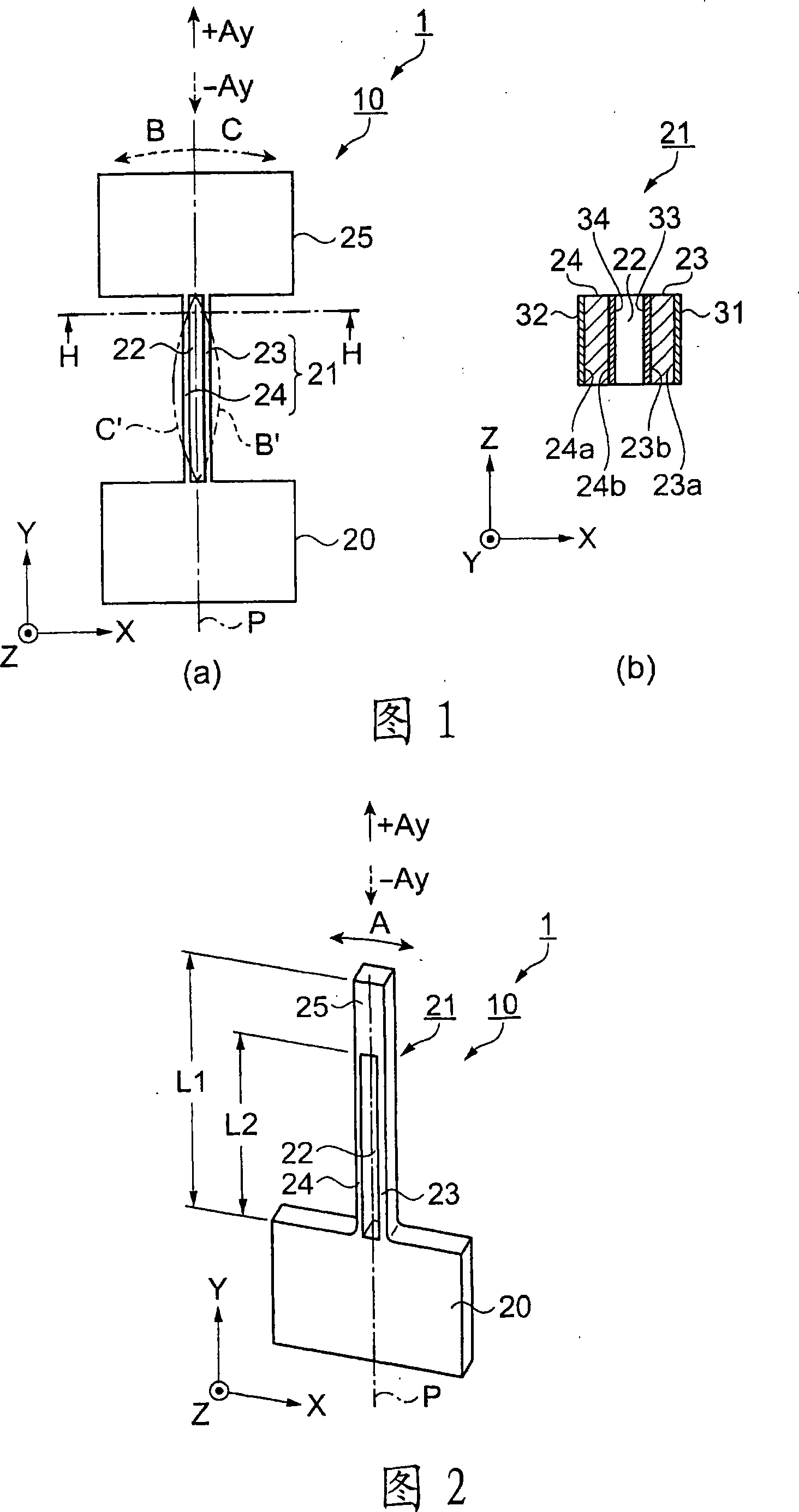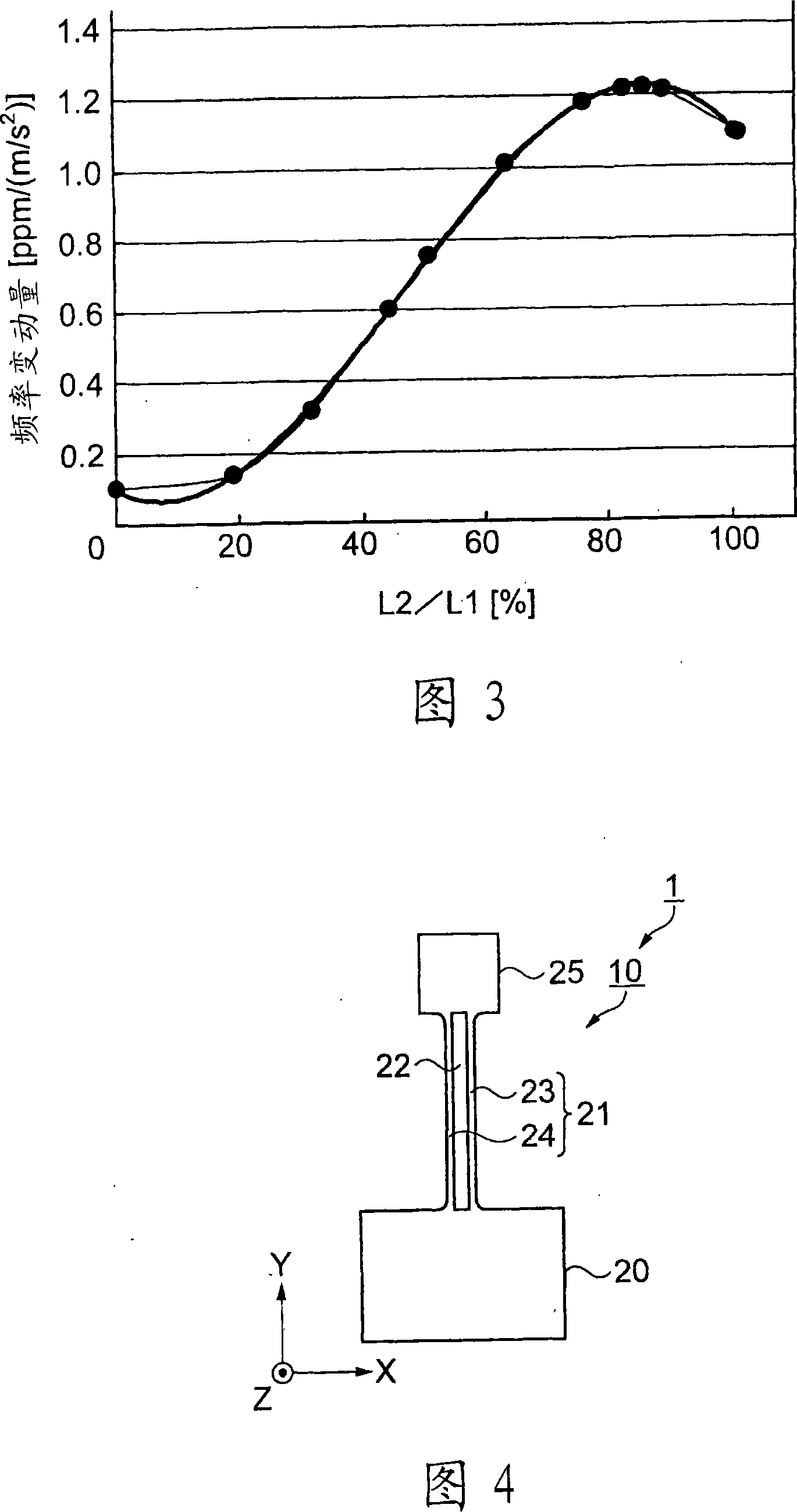Acceleration sensor
An acceleration sensor and acceleration technology, applied in the direction of acceleration measurement using inertial force, etc., can solve the problems of difficulty in ensuring long-term reliability of the joint, difficulty in improving position accuracy, and difficulty in miniaturization, etc., to ensure long-term reliability and eliminate frequency Influence of temperature characteristics, effect of miniaturization
- Summary
- Abstract
- Description
- Claims
- Application Information
AI Technical Summary
Problems solved by technology
Method used
Image
Examples
no. 1 Embodiment approach
[0075] 1 shows an example of an acceleration sensor according to the first embodiment, (a) is a front view, and (b) is a cross-sectional view showing a H-H cross section of (a). In Fig. 1 (a), the acceleration sensor 1 is composed of a vibrating body 10. The vibrating body 10 has a base 20 fixed on a base (not shown), and extends from the end face of the base 20 and vibrates at a predetermined resonant frequency. The beam-shaped vibrating arm 21 flexurally vibrates in the planar direction.
[0076] The vibrating body 10 is formed of a piezoelectric material. As the piezoelectric material, lead titanate (PbTiO 3 ), lead zirconate titanate (PZT (registered trademark)), zinc oxide (ZnO), quartz, etc., but in this embodiment, a case of using quartz having excellent frequency temperature characteristics and a high Q value will be described as an example.
[0077] The vibrating body 10 is a Z-cut plate developed on the XY plane, and a simple beam-shaped vibrating arm 21 is formed ...
Deformed example 1
[0102] Next, an acceleration sensor according to Modification 1 of the first embodiment will be described with reference to the drawings. Modification 1 is characterized in that the vibrating body performs primary bending vibration with a single-end fixed structure. FIG. 2 is a perspective view showing the configuration of an acceleration sensor according to Modification 1. FIG. In FIG. 2 , the vibration body 10 serving as an acceleration sensor has the same shape as that of the first embodiment (see FIG. 1 ), except for the additional mass portion 25 . The additional mass part 25 is provided on the extension line of the vibrating arm 21 , and the vibrating arm 21 is divided into vibrating arm parts 23 and 24 by the through opening 22 .
[0103] The excitation electrodes 31 to 34 shown in FIG. 1 are provided on the side surfaces of the vibrating arm portions 23 and 24 . If excitation signals of opposite potentials are input from the oscillation circuit to excitation electrod...
Deformed example 2
[0111] Next, an acceleration sensor according to Modification 2 of the first embodiment will be described with reference to the drawings. Modification 2 is characterized in that the free end of the vibrating arm is provided with a large additional mass portion capable of primary bending vibration. Therefore, the description will mainly focus on differences from the above-mentioned first embodiment (see FIG. 1 ). Common parts are given the same symbols as in the first embodiment.
[0112]FIG. 4 is a front view showing a vibrator according to this modification. In FIG. 4 , the beam-shaped vibrating arm 21 of the vibrating body 10 extends vertically in the Y-axis direction from the center of one side of the base 20 . A through-opening 22 is opened along the longitudinal direction (Y-axis direction) at the center of the vibrating arm 21 in the width direction (X-axis direction), and the through-opening 22 penetrates through the thickness direction (Z-axis direction).
[0113] T...
PUM
 Login to View More
Login to View More Abstract
Description
Claims
Application Information
 Login to View More
Login to View More - R&D
- Intellectual Property
- Life Sciences
- Materials
- Tech Scout
- Unparalleled Data Quality
- Higher Quality Content
- 60% Fewer Hallucinations
Browse by: Latest US Patents, China's latest patents, Technical Efficacy Thesaurus, Application Domain, Technology Topic, Popular Technical Reports.
© 2025 PatSnap. All rights reserved.Legal|Privacy policy|Modern Slavery Act Transparency Statement|Sitemap|About US| Contact US: help@patsnap.com



